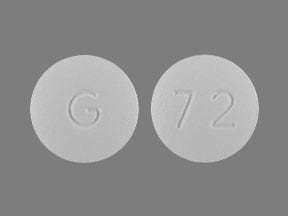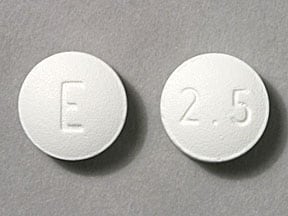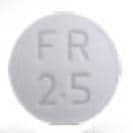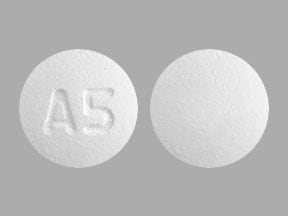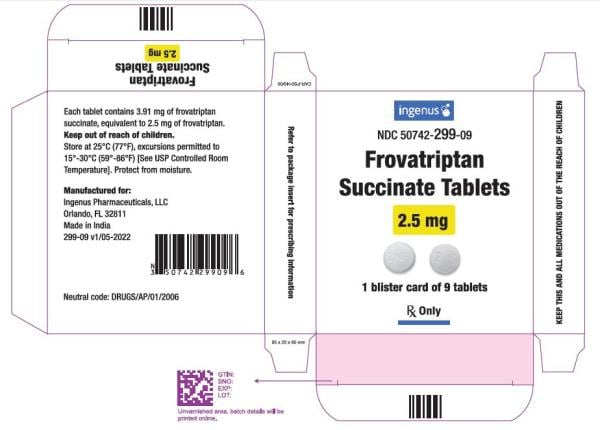Dosage Forms
Excipient information presented when available (limited, particularly for generics); consult specific product labeling.
Tablet, Oral:
Frova: 2.5 mg
Generic: 2.5 mg
Pharmacology
Mechanism of Action
Selective agonist for serotonin (5-HT1B and 5-HT1D receptors) in cranial arteries; causes vasoconstriction and reduces sterile inflammation associated with antidromic neuronal transmission correlating with relief of migraine.
Pharmacokinetics/Pharmacodynamics
Distribution
Male: 4.2 L/kg; Female: 3 L/kg
Metabolism
Primarily hepatic via CYP1A2
Excretion
Feces (62%); urine (32%)
Time to Peak
2-4 hours
Half-Life Elimination
~26 hours
Protein Binding
~15%
Use in Specific Populations
Special Populations: Hepatic Function Impairment
In patients with mild (Child-Pugh class 5 to 6) to moderate (Child-Pugh class 7 to 9) hepatic function impairment, AUC increased 2 times that of healthy subjects.
Special Populations: Elderly
AUC was 1.5- to 2-fold higher in elderly subjects.
Special Populations: Gender
Bioavailability was higher and systemic exposure was approximately 2-fold greater in females than males.
Use: Labeled Indications
Migraines: Acute treatment of migraine with or without aura in adults
Limitations of use: For use only in patients with a clear diagnosis of migraine. Not indicated for prevention of migraine attacks or the treatment of cluster headache.
Use: Off Label
Menstrually-associated migraines (short-term prevention)a
Data from one randomized, double-blind, placebo-controlled, three-way crossover study demonstrated that frovatriptan given prophylactically for 6 days prior to anticipated start of menstruation was effective in reducing the incidence of menstrually associated migraine compared to placebo Silberstein 2012. Another randomized, double-blind, placebo-controlled, parallel-group study demonstrated that the number of headache-free perimenstrual periods was higher with a 6-day regimen of frovatriptan twice daily or once daily dosing compared to placebo Brandes 2009.
Contraindications
Ischemic coronary artery disease (eg, angina pectoris, history of MI, documented silent ischemia); coronary artery vasospasm, including Prinzmetal's angina; Wolff-Parkinson-White syndrome or arrhythmias associated with other cardiac accessory conduction pathway disorders; history of stroke, transient ischemic attack, or history of hemiplegic or basilar migraine; peripheral vascular disease; ischemic bowel disease; uncontrolled hypertension; recent use (within 24 hours) of another 5-HT1 agonist, an ergotamine containing or ergot-type medication (eg, dihydroergotamine, methysergide); hypersensitivity to frovatriptan or any component of the formulation.
Canadian labeling: Additional contraindications (not in US labeling): Cardiac arrhythmias (especially tachycardia) or valvular heart disease, congenital heart disease, atherosclerotic disease; management of ophthalmoplegic migraine; severe hepatic impairment
Documentation of allergenic cross-reactivity for triptans is limited. However, because of similarities in chemical structure and/or pharmacologic actions, the possibility of cross-sensitivity cannot be ruled out with certainty.
Dosage and Administration
Dosing: Adult
Note: If the first dose is ineffective, diagnosis needs to be re-evaluated. The safety of treating >4 migraines/month has not been established.
Migraine: Oral: Initial: 2.5 mg; if headache recurs, a second dose may be administered after 2 hours have elapsed since the first dose (maximum: 7.5 mg/day)
Dosing: Geriatric
Refer to adult dosing.
Administration
Administer orally with fluids as soon as symptoms appear.
Storage
Store at 25°C (77°F); excursions are permitted between 15°C and 30°C (59°F and 86°F). Protect from moisture.
Frovatriptan Images
Drug Interactions
Droxidopa: Serotonin 5-HT1D Receptor Agonists (Triptans) may enhance the hypertensive effect of Droxidopa. Monitor therapy
Ergot Derivatives: May enhance the vasoconstricting effect of Serotonin 5-HT1D Receptor Agonists (Triptans). Serotonin 5-HT1D Receptor Agonists (Triptans) may enhance the vasoconstricting effect of Ergot Derivatives. Exceptions: Nicergoline. Avoid combination
Monoamine Oxidase Inhibitors: Serotonin 5-HT1D Receptor Agonists (Triptans) may enhance the serotonergic effect of Monoamine Oxidase Inhibitors. This could result in serotonin syndrome. Monoamine Oxidase Inhibitors may increase the serum concentration of Serotonin 5-HT1D Receptor Agonists (Triptans). Exceptions: Rasagiline; Safinamide; Selegiline. Avoid combination
Serotonergic Agents (High Risk): Serotonin 5-HT1D Receptor Agonists (Triptans) may enhance the serotonergic effect of Serotonergic Agents (High Risk). This could result in serotonin syndrome. Management: Monitor for signs and symptoms of serotonin syndrome/serotonin toxicity (eg, hyperreflexia, clonus, hyperthermia, diaphoresis, tremor, autonomic instability, mental status changes) when these agents are combined. Exceptions: Isocarboxazid; Linezolid; Methylene Blue; Moclobemide; Phenelzine; Tranylcypromine. Monitor therapy
SUMAtriptan: Serotonin 5-HT1D Receptor Agonists (Triptans) may enhance the adverse/toxic effect of SUMAtriptan. Avoid combination
Adverse Reactions
1% to 10%:
Cardiovascular: Flushing (4%), hot or cold flashes (3%), chest pain (2%), palpitations (1%)
Central nervous system: Dizziness (8%), fatigue (5%), headache (4%), paresthesia (4%), drowsiness (≥2%), anxiety (1%), dysesthesia (1%), hypoesthesia (1%), insomnia (1%), pain (1%)
Dermatologic: Diaphoresis (1%)
Gastrointestinal: Xerostomia (3%), nausea (≥2%), dyspepsia (2%), abdominal pain (1%), diarrhea (1%), vomiting (1%)
Neuromuscular & skeletal: Musculoskeletal pain (3%)
Ophthalmic: Visual disturbance (1%)
Otic: Tinnitus (1%)
Respiratory: Rhinitis (1%), sinusitis (1%)
<1%, postmarketing, and/or case reports: Abnormal dreams, abnormal gait, abnormal lacrimation, abnormal reflexes, agitation, amnesia, anaphylactoid reaction, anaphylaxis, anorexia, arthralgia, ataxia, back pain, bradycardia, bullous rash, change in bowel habits, cheilitis, chest tightness, confusion, conjunctivitis, constipation, dehydration, depersonalization, depression, dysgeusia, dysphagia, dyspnea, ECG changes, emotional lability, epistaxis, eructation, esophageal spasm, euphoria, eye pain, fever, flatulence, gastroesophageal reflux disease, hiccups, hyperacusis, hyperesthesia, hypersensitivity reaction (including angioedema), hypertonia, hyperventilation, hypocalcemia, hypoglycemia, hypotonia, increased thirst, involuntary muscle movements, jaw tightness, lack of concentration, laryngitis, leg pain, malaise, mouth edema, myalgia, myasthenia, myocardial infarction, nervousness, nocturia, osteoarthritis, otalgia, peptic ulcer, personality disorder, pharyngitis, polyuria, pruritus, purpura, renal pain, rigors, salivary gland pain, seizure, sialorrhea, significant cardiovascular event, speech disturbance, stomatitis, syncope, tachycardia, tightness in chest and throat, tongue paralysis, toothache, tremor, urinary frequency, urine abnormality, vertigo, weakness
Warnings/Precautions
Concerns related to adverse effects:
- Anaphylactic/Anaphylactoid reactions: Anaphylaxis, anaphylactoid, and hypersensitivity reactions (including angioedema) have occurred; may be life-threatening or fatal. Use is contraindicated in patients with known hypersensitivity to frovatriptan.
- Cardiac events: Coronary artery vasospasm, transient ischemia, myocardial infarction, ventricular tachycardia/fibrillation, cardiac arrest, and death have been reported with 5-HT1 agonist administration; some events have occurred within a few hours of administration. Discontinue if these events occur. Patients who experience sensations of chest pain/pressure/tightness or symptoms suggestive of angina following dosing should be evaluated for coronary artery disease or Prinzmetal's angina before receiving additional doses; if dosing is resumed and similar symptoms recur, monitor with ECG. Use is contraindicated in patients with ischemic or vasospastic CAD and Wolff-Parkinson-White syndrome or arrhythmias associated with other cardiac accessory conduction pathway disorders.
- Cerebrovascular events: Cerebral/subarachnoid hemorrhage and stroke (some fatal) have been reported with 5-HT1 agonist administration. Use is contraindicated in patients with a history of stroke or transient ischemic attack.
- Elevated blood pressure: Significant elevation in blood pressure, including hypertensive crisis with acute impairment of organ systems, has also been reported on rare occasions in patients with and without a history of hypertension. Monitor blood pressure; use is contraindicated in patients with uncontrolled hypertension.
- Headaches: Acute migraine agents (eg, triptans, opioids, ergotamine, or a combination of the agents) used for ≥10 days per month may lead to worsening of headaches (medication overuse headache); withdrawal treatment may be necessary in the setting of overuse.
- Vasospasm-related events: Peripheral vascular ischemia, gastrointestinal vascular ischemia and infarction, splenic infarction, and Raynaud syndrome have been reported with 5-HT1 agonist administration.
- Visual effects: Partial vision loss and blindness (transient and permanent) have been reported with use of 5-HT1 agonists; a causal relationship between these events and 5-HT1 agonist administration has not been clearly determined.
Disease-related concerns:
- Coronary artery disease: Should not be given to patients who have risk factors for CAD (eg, hypertension, hypercholesterolemia, smoker, obesity, diabetes, strong family history of CAD, menopause, male >40 years of age) without adequate cardiac evaluation. Use is contraindicated if there is evidence of CAD or coronary artery vasospasm. Patients with suspected CAD should have cardiovascular evaluation to rule out CAD before considering use; if cardiovascular evaluation is “satisfactory,” first dose should be given in the healthcare provider's office (consider ECG monitoring). Periodic evaluation of cardiovascular status should be done in all patients.
- Hepatic impairment: Use with caution in severe impairment (has not been studied).
Concurrent drug therapy issues:
- Drug-drug interactions: Potentially significant interactions may exist, requiring dose or frequency adjustment, additional monitoring, and/or selection of alternative therapy. Consult drug interactions database for more detailed information.
- Serotonin syndrome: Symptoms of agitation, confusion, hallucinations, hyper-reflexia, myoclonus, shivering, and tachycardia may occur with concomitant proserotonergic drugs (eg, SSRIs/SNRIs or triptans) or agents which reduce frovatriptan's metabolism. Concurrent use of serotonin precursors (eg, tryptophan) is not recommended. If concomitant administration with SSRIs is warranted, monitor closely, especially at initiation and with dose increases. Discontinue frovatriptan if serotonin syndrome is suspected.
Special populations:
- Elderly: Blood pressure was increased to a greater extent in elderly subjects than in younger subjects.
Other warnings/precautions:
- Appropriate use: Only indicated for treatment of acute migraine. If a patient does not respond to the first dose, the diagnosis of migraine should be reconsidered; rule out underlying neurologic disease in patients with atypical headache, migraine (with no prior history of migraine) or inadequate clinical response to initial dosing.
Monitoring Parameters
Headache severity, blood pressure, signs/symptoms suggestive of angina; perform a cardiovascular evaluation in triptan-naïve patients who have multiple cardiovascular risk factors (eg, increased age, diabetes, hypertension, smoking, obesity, strong family history of CAD), monitor ECG with first dose in patients with multiple cardiovascular risk factors who have a negative cardiovascular evaluation and consider periodic cardiovascular evaluation in such patients if they are intermittent long-term users; signs/symptoms of serotonin syndrome and hypersensitivity reactions.
Pregnancy
Pregnancy Considerations
Adverse events were observed in animal reproduction studies. Information related to the use of frovatriptan in pregnancy has not been located. Until additional information is available, other agents are preferred for the initial treatment of migraine in pregnancy (Da Silva 2012; MacGregor 2012; Williams 2012).
Patient Education
- Discuss specific use of drug and side effects with patient as it relates to treatment. (HCAHPS: During this hospital stay, were you given any medicine that you had not taken before? Before giving you any new medicine, how often did hospital staff tell you what the medicine was for? How often did hospital staff describe possible side effects in a way you could understand?)
- Patient may experience loss of strength and energy, dry mouth, flushing, sensation of warmth, bone pain, or joint pain. Have patient report immediately to prescriber signs of serotonin syndrome (dizziness, severe headache, agitation, sensing things that seem real but are not, fast heartbeat, abnormal heartbeat, flushing, tremors, sweating a lot, change in balance, severe nausea, or severe diarrhea), signs of severe cardiac abnormalities (chest, throat, neck, or jaw tightness, pain, pressure, or heaviness; break out in a cold sweat; shortness of breath; fast heartbeat; abnormal heartbeat; or severe dizziness or passing out), signs of severe cerebrovascular disease (change in strength on one side is greater than the other, difficulty speaking or thinking, change in balance, or vision changes), vision changes, blindness, severe nausea, vomiting, severe or persistent headache, severe dizziness, passing out, constipation, diarrhea, severe abdominal pain, bloody diarrhea, weight loss, leg cramps, leg heaviness or tightness, sensation of cold, burning or aching in feet or toes, shortness of breath, burning or numbness feeling, or blue/gray skin discoloration (HCAHPS).
- Educate patient about signs of a significant reaction (eg, wheezing; chest tightness; fever; itching; bad cough; blue skin color; seizures; or swelling of face, lips, tongue, or throat). Note: This is not a comprehensive list of all side effects. Patient should consult prescriber for additional questions.
Intended Use and Disclaimer: Should not be printed and given to patients. This information is intended to serve as a concise initial reference for health care professionals to use when discussing medications with a patient. You must ultimately rely on your own discretion, experience, and judgment in diagnosing, treating, and advising patients.
